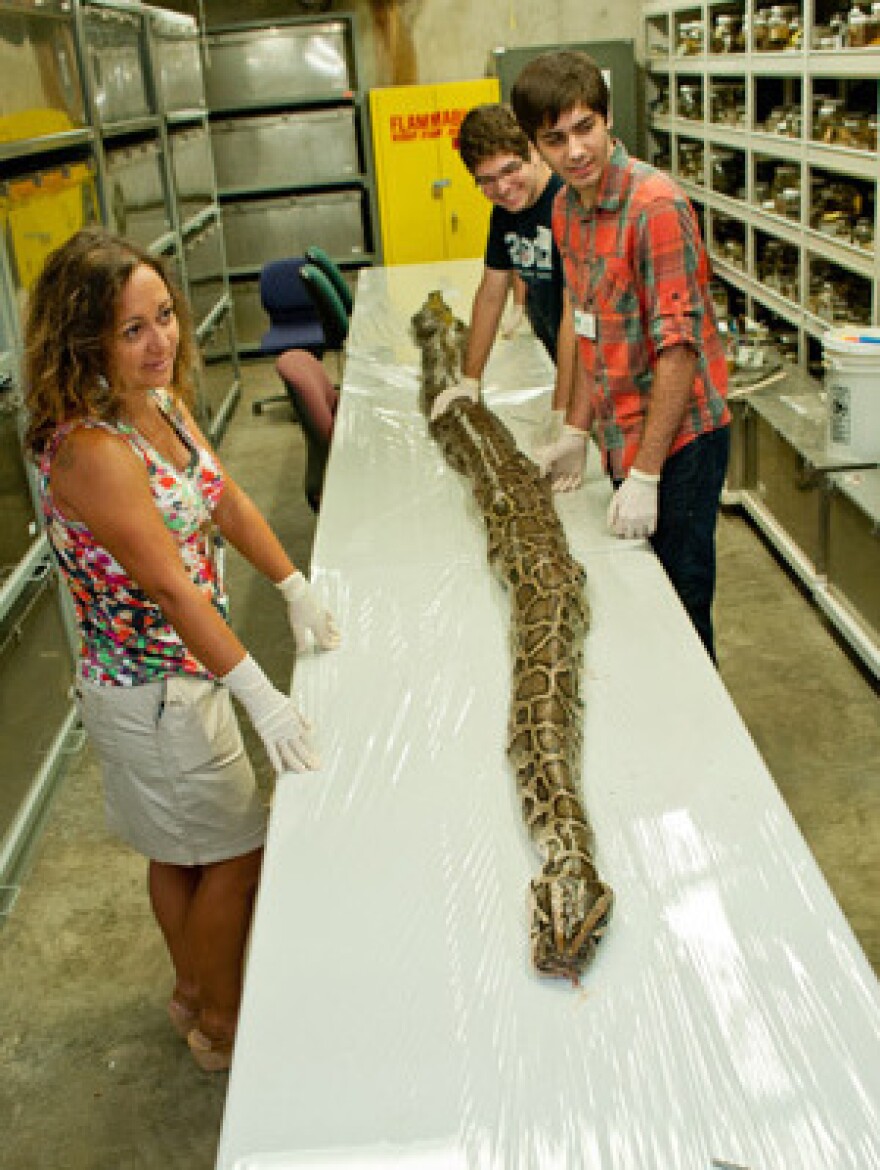She was about three feet longer than the distance from an NBA free throw line to the basket. She was a bit more than twice the height of many bedroom ceilings. You could park two Smart Cars beside her with a foot or so to spare.
Those are some ways to get a sense of just how big the biggest Burmese python discovered so far in Florida was.

University of Florida researchers say the snake was 17 feet, 7 inches long — about a foot more than the previous Florida record-holder. She weighed 164.5 pounds. And inside was another record find: 87 eggs. The previous record "clutch" was 85.
The Palm Beach Post says the snake was "initially captured March 6 and returned to the wild days later after being fitted with two radio transmitters and other devices to track its movements. ... The snake was recaptured April 19 and euthanized shortly afterward."
Researchers at Everglades National Park are studying such snakes in an attempt to figure out how to manage them. As the Post adds:
"Pythons have become a huge issue for state wildlife managers. They're aggressive enough to consume most other species they come into contact with — even deer and alligators. About 1,800 pythons have been removed from the park and nearby areas since 2002."
According to the university, "native to Southeast Asia and first found in the Everglades in 1979, the Burmese python is one of the deadliest and most competitive predators in South Florida. With no known natural predator, population estimates for the python range from the thousands to hundreds of thousands."
Update at 5:20 p.m. ET. When It Was Still Alive:
The USGS just posted a video of the snake when it was still alive. It gives you a sense of its power and gives you a sense of its incredible size.
Update at 2:55 p.m. ET. Pythons Are Putting Other Animals At Even Greater Risk:
Kristen Hart, a research ecologist for the U.S. Geological Survey who was part of the team that studied the snake, told NPR's Melissa Block this afternoon that there are likely "tens of thousands" of the pythons in the Everglades now. The reason to study and eliminate many of them is that the snakes can eat just about any other type of creature (including alligators) and are putting several endangered species at even greater risk. "They have the potential to knock out" animals such as the wood stork and woodrats in the Everglades, Hart said.
More from their conversation is due on today's All Things Considered. Click here to find an NPR station that broadcasts or streams the show. Later, we'll add the as-broadcast version of the interview to the top of this post.
Meanwhile, Bloomberg News has posted a short video showing the Florida researchers working on the dead snake.
Update at 12:15 p.m. ET. Killed To Keep From Reproducing And As Part Of Study:
As we said earlier, the snake was captured, tracked and eventually killed as part of the researchers' work studying the pythons and trying to figure out how best to control their population. The Miami Herald adds this background:
"The big female was first captured on March 6 when a male 'Judas snake' lead a team to her not far from the park's research center, said Kristen Hart, a research ecologist for the U.S. Geological Survey. The 'Judas snake" project fits pythons with tiny radio transmitters and GPS devices, then releases them into the wild, with the hope they will lead scientists to primary breeding spots.
"Because of its size, the record-breaking female snake also was briefly employed in the project, fitted with a radio transmitter, GPS and accelerometers that measured its precise body movements every four seconds. Before it could lay any eggs, it was recaptured on April 19, after 38 days in the wild, and euthanized, Hart said."
Note at 11:50 a.m. ET. A Slight Recalculation: A sharp-eyed editor figured out that two Mini Coopers wouldn't quite fit next to the snake (earlier, we mistakenly based that estimate on the Mini's wheelbase, not total length). But a look at the specs of a Smart Car shows it stretches just 8.8 feet. So, two of them would be just about perfect beside this python. We've switched to a Smart Car comparison in the post above.
Copyright 2020 NPR. To see more, visit https://www.npr.org. 9(MDAyNDY5ODMwMDEyMjg3NjMzMTE1ZjE2MA001))




